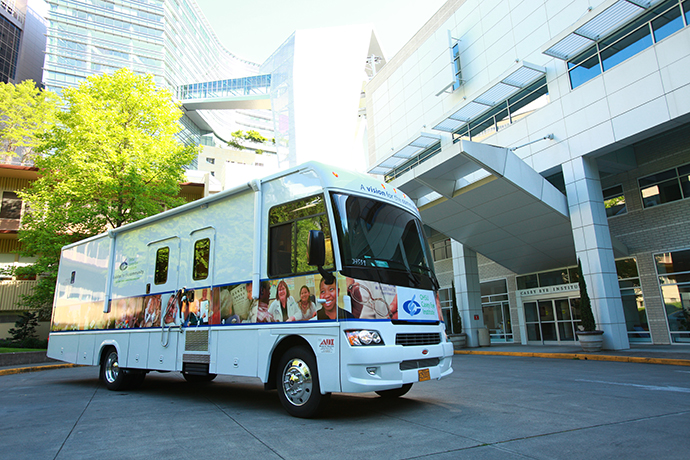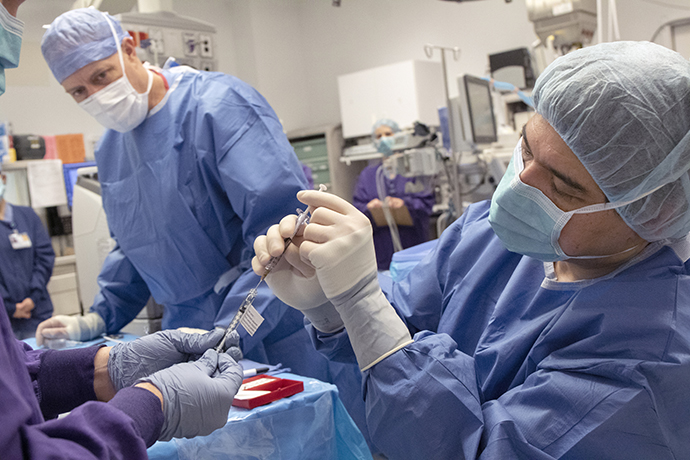New facility expands pediatric care and clinical trial capacity

As 2020 came to a close, the new Oregon Elks Children’s Eye Clinic opened a new era in OHSU Casey Eye Institute. The new facility is a critical resource for growing programs to provide services for eliminating blindness. The Oregon Elks Children’s Eye Clinic is the nation’s first free-standing eye institute for pediatric patients. It is a world-class hub for innovative research, subspecialty patient care and leadingedge programs in gene therapy, preschool vision screening and telemedicine for retinopathy of prematurity. Also housed in the new building, the Wold Family Macular Degeneration Center will further Casey’s decades long work studying macular degeneration’s underlying causes and evaluating bench-to-bedside treatments, including gene and stem cell therapies. Additionally, the Ophthalmic Genetics Program will reside in the building to better accommodate the growing number of clinical trials, anticipating that patient volumes will triple in the next five years.
Mobile eye clinic celebrates 10 years

OHSU Casey Eye Institute’s mobile eye clinic travels throughout Oregon to provide free eye exams with the purpose of identifying sight-threatening conditions in lowincome adults before they can cause blindness. The mobile clinic is the only adult vision screening program in Oregon that offers complete eye exams under the supervision of an ophthalmologist who can diagnose serious eye conditions. OHSU Casey Eye Institute will be adding and equipping a second mobile clinic to expand coverage in 2021. OHSU Casey Community Outreach Program, 2010-present:
- 300 clinic days held
- 10,015 people provided free eye exams
- 5,934 glasses prescriptions given
- 2,358 people received referrals for urgent needs that immediately threatened
their sight - 28,482 volunteer hours
- 71 partner agencies and organizations have hosted the
program’s mobile clinics
Abundance of clinical trials

At OHSU Casey Eye Institute, we are rooted in a culture that questions the status quo and pushes the boundaries of what is possible. We are bringing new science and technology to the diagnosis and treatment of eye diseases. We accomplish this by creating a culture in which translational science can thrive. With dozens of clinical trials upcoming or underway, our clinician investigators collaborate with multidisciplinary research teams to make scientific progress toward eliminating preventable blindness for conditions such as retinitis pigmentosa, choroideremia, advanced dry macular degeneration. Some examples include:
- Phase I/IIa Open Label Prospective Study of the Safety and Tolerability of the Human Retinal Progenitor Cell (hRPC) Therapy Candidate in the Treatment of Patients with Retinitis Pigmentosa. (First patient treated January 12, 2021.)
- STAR trial: A Randomized, Open Label, Outcomes-Assessor Masked, Prospective, Parallel Controlled Group, Phase 3 Clinical Trial of Retinal Gene Therapy for Choroideremia Using an Adeno-Associated Viral Vector (AAV2) Encoding Rab Escort Protein 1 (REP1)’.
- GEMINI trial: An Open-Label Safety Study of Retinal Gene Therapy for Choroideremia with Bilateral, Sequential Administration of Adeno-associated Viral Cector (AAV2) Encoding rab Escort Protein 1 (REP1). Phase I/II Study to Look at the Safety of Bilateral Administration of Gene Therapy for Choroideremia.
- BRILLIANCE trial: Open-Label, Single Ascending Dose Study to Evaluate the Safety, Tolerability, and Efficacy of EDIT-101 in Adult and Pediatric Participants with Leber Congenital Amaurosis Type 10 (LCA10), with Centrosomal Protein 290 (CEP290)-Related Retinal Degeneration Caused by a Compound Heterozygous or Homozygous Mutation Involving c.2991+1655A>G in Intron 26 (IVS26) of the CEP290 Gene (“LCA10-IVS26”).
- GALLEGO trial: A Phase II Multicenter, Randomized, Single-Masked, Sham-Controlled Study to Assess Safety, Tolerability, and Efficacy of Interavitreal Injections of FHTR2163 in Patients with Geographic Atrophy Secondary to Age-Related Marcular Degeneration.
- GYROSCOPE: A Study of Disease Progression in Genetically Defined Subjects With Geographic Atrophy Secondary to Age-Related Macular Degeneration.
6/6: C (S ee)-Day
Research shows that one of the principal barriers to preventing blindness is lack of awareness. OHSU Casey Eye Institute has adopted June 6 as C-Day, since 6/6 is considered perfect vision in the metric system. Each June 6, OHSU Casey Eye Institute will encourage public awareness of the importance of vision and host an annual symposium, the Oregon Ophthalmological Alumni Association Meeting.